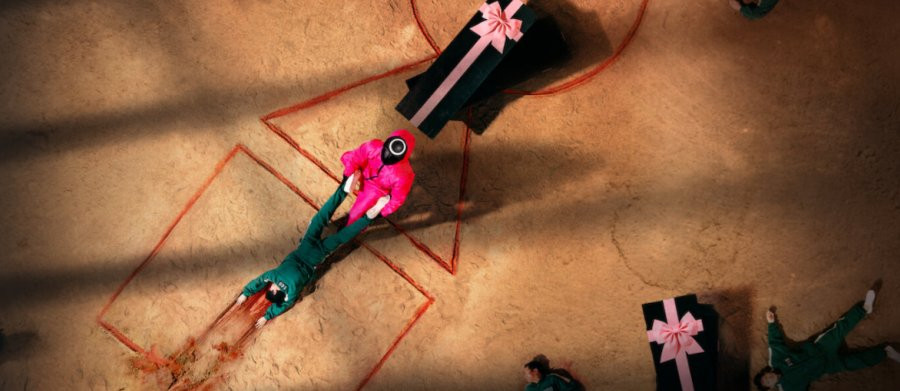
WandaVision
2021 - United States‘Within the documentary of the programme’s making, WandaVision was perfectly described as a complicated Rubik’s cube of a show’
WandaVision review by Brian Slade
When phase three of the Marvel Cinematic Universe came to an epic conclusion with Avengers: Endgame, fans were left to wonder just how well the writers could keep the Marvel juggernaut rolling. For 22 movies, Marvel’s most iconic heroes and villains had achieved success after success at the box office, but with the body count high in Endgame and Disney now needing fresh material for their new streaming platform, the first toe in the water since the Avengers’ dramatic clash with Thanos was always going to be a tricky one. That initial effort was as quirky as they come, with the Scarlet Witch and Vision leading the way in the well-received WandaVision.

Wanda Maximoff (Elizabeth Olsen) was one of those unfortunates who didn’t get everything back when the damage done by the click of Thanos’s thumb and forefinger that wiped out half of the world’s population at the end of Avengers: Infinity War was reversed in Avengers: Endgame. The relationship she had with Vision (Paul Bettany) was gone before Thanos worked his evil magic as the infinity stone in the centre of his forehead became pivotal to the events of the storyline and his death was a necessary evil to try and save the world.
When we first pick up Wanda’s story in the opening episode of WandaVision, we do so in 4:3 picture ratio, black and white and with a studio audience’s laughter as a soundtrack to the life that Wanda and Vision are now leading in the seemingly idyllic American town of Westview, New Jersey. Wanda is capable of tidying the kitchen and magicking up dinner in the same unique manner that Samantha did with the wiggle of her nose in Bewitched. Vision seems a little more confused, but nonetheless happy at the small-town America life they seem to be leading.

Neighbour to the pair is Agnes (Kathryn Hahn), always seemingly present in their home and increasing in significance as the show progresses. That progression sees each episode move on, drifting into colour and widescreen and going through the changing fashions of the decades, mirroring the sitcoms of each time. Agnes is an ever present, as is the increasing confusion in Vision’s mind. The world he inhabits and the swift changes around him, such as the arrival of two sons, don’t seem real…nor are they.

If the viewer was exposed solely to these on-screen sitcom images, WandaVision may well have been a bemusing and flawed show, lost in its early stages. But outside of this, we also see the return of Jimmy Woo (Randall Park), previously most heavily involved in the Ant-man story arc and now sent to investigate a missing persons report in the town of Westview. When he arrives, Westview is seemingly gone and those who had resided there are oblivious that it had ever existed. It’s only when agent Monica Rambeau (Teyonah Parris) arrives that we discover that Westview has a forcefield around it protecting the town from any outside intrusion.

What follows is an increasing awareness of Vision that all is not right with his life and his town, nor indeed with Wanda, whose attempts to reassure him become ever more desperate. Agnes remains a constant and they are now joined by Rambeau, who has been sucked into the town through the forcefield and is now a character in the sitcom called Geraldine, until her behaviour and knowledge is detected and she is ejected.
Outside the field, Woo and Darcy Lewis (Kat Dennings), previously seen in the Thor movies, eventually realise what, and indeed who, is controlling things within Westview and what they need to do to rectify it and rescue the inhabitants.
It’s hard to pinpoint the reason for the success of WandaVision, or indeed explain the later goings on of the show without major spoilers. However, and look away now if you don’t want to know, Vision is actually a creation of the mind of Wanda, who has in fact used her phenomenal powers to create the entire situation to deal with her grief. But the power she used was detected by Agatha Harkness, a witch of remarkable powers, and who in the form of Agnes causes the mayhem that follows. Hahn is superbly villainous in that role. As for Vision himself, we discover a character called White Vision, the actual fallen victim of the actions in the Avengers movies, who has both physical battles and deep discussions with the Vision created from the powers of Wanda in the show.

Within the documentary of the programme’s making, WandaVision was perfectly described as a complicated Rubik’s cube of a show. The producers went for a completely different line of approach, with a sense of mystery and intrigue that kept viewers coming back to try and understand the parade of sitcom mimicry their characters were inhabiting. Filmed in front of a live studio audience for the earlier episodes, the producers went for an authentic tribute to those sitcoms rather than a mocking parody, and the approach worked superbly.
As ever with Marvel stories, there were plenty of questions that remained unanswered when WandaVision concluded – ones that inevitably will lead on into the next phases of the Marvel Cinematic Universe. WandaVision was a major risk for Marvel. The loss of major characters at the end of Avengers: Endgame meant that the next moves would be crucial if the MCU were to continue its remarkable success. That they chose to use such a unique approach and executed it so expertly meant that WandaVision remains one of Marvel’s most praised creations and set Disney up nicely for its small screen offerings to come.
Seen this show? How do you rate it?
Seen this show? How do you rate it?
Published on July 21st, 2023. Written by Brian Slade for Television Heaven.










